Knowing how to properly repair a punctured tire can save you money, as well as keep you from being
stranded
on the side of the road.
Luckily, a couple of easy-to-follow methods exist for repairing a punctured tire.
While you should ultimately have your tires inspected and replaced if necessary following a tire repair, the methods below provide a great temporary fix to a punctured tire until you can get to a tire store.
Here's how to plug and patch a tire.
RECOMMENDED
No spam or unwanted phone calls · No long forms · No fees, ever
ZIP Code
ZIP Code
Find insurance savings (100% Free)
Using a tire plug to repair a punctured tire
A tire plug kit helps patch a tire quickly and easily. Considered a safer alternative to patches and sealant, a tire plug actually inserts into the tire. It then expands to plug any holes.
Here are the steps for how to plug a tire.
Step 1: Remove tire. Start by removing the punctured tire.
Step 2: Pull out object. Pull out the object that punctured the tire.
Step 3: Clean hole. Clean the puncture hole using a rasp tool, which you can find at brick-and-mortar stores like The Home Depot and Advanced Auto Parts.
A tire plug kit should contain various tools, one of which is a rasp tool.
The rasp tool can help the plug hold by roughening the tire material in the hole where you want to place the plug.
Step 4: Apply adhesive. Apply the adhesive that came with the tire plug kit.
Common adhesives include rubber cement or some other type of glue.
This glue can initially help lubricate the puncture hole, making it easier to get the plug through.
Step 5: Insert plug. Using the insertion tool, which also comes with your kit, insert the plug into the puncture hole.
Using the insertion tool, which also comes with your kit, insert the plug into the puncture hole.
While difficult to insert in some cases, you can get the plug to fit by squeezing down one of the end of the plug material.
Once the adhesive has dried, cut away any excess material from the plug using a razor or knife.
Step 6: Place air in the tire. Fill the tire to the recommended air pressure, which you can find inside the wall of the tire or in the owner's manual.
Test the seal of the tire plug by squirting a soap/water mix on the puncture area.
If needed, apply more adhesive or try using another plug.
Using tire sealant to repair a punctured tire
Flat tire sealant, such as
Fix-a-Flat
, provides a fast and easy way to fix a punctured tire—as long as the puncture is not too large. You should have the tire professionally repaired or replaced if the puncture is larger than one-quarter inch.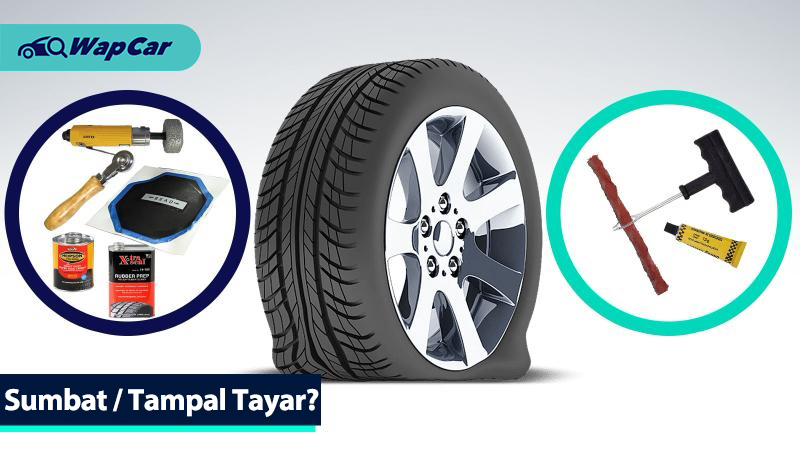
The following steps walk you through the process of using sealant to patch your tire.
Step 1: Remove the object. First, remove the object that punctured your tire.
Step 2: Position the tire. Position the tire so that the valve stem rests at the top of the wheel.
Remove the valve stem cap.
Step 3: Attach tire sealant nozzle. Attach the nozzle from the tire sealant can to the valve stem.
Press the button releasing the sealant into the tire.
Step 4: Drive the car. Drive the car around until the sealant has spread evenly throughout the tire.
This step is necessary to keep the sealant from forming a lump in one area and unbalancing the tire.
Step 5: Replace the tire. Make sure to replace the tire within a certain time limit.
Sealants are only meant to get you to where you can get the tire replaced. Most sealants only last for 100 miles or three days.
To minimize the chances of a punctured tire, try to
avoid driving over potholes and other rough areas in the street, as well as on the side of the road where debris collects.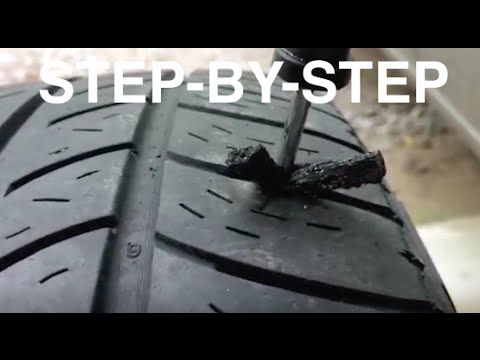
Even given your best efforts, a punctured tire is bound to happen. And when it does, you can use one of the above methods to fix it on the spot. Just remember to take your car to a professional tire shop to have the punctured tire inspected for safety, and replaced if necessary. And don't forget to keep an eye out for
slow leaks
.
If your tires were damaged in an accident or another covered peril, you should contact your insurance company.
Jerry
is the easiest and most effective way to find a car insurance policy that is customized for you.
After providing you with a comprehensive cross-analysis of the best policies across providers, Jerry will handle the phone calls, paperwork, and renewals for your top pick so that you don’t have to. They even help cancel your old policy! So why do all that extra work when Jerry can do it better?
RECOMMENDED

Judith switched to Progressive
Saved $
725
annually
Alexander switched to Travelers
Saved $
834
annually
Annie switched to Nationwide
Saved $
668
annually
So, you have a flat tire or one that’s leaking air. It’s not the end of the world. Luckily there are safe and cost-effective ways to properly repair most tire punctures. The purpose of this article is to show you the difference between a safe, permanent repair and a temporary string, plug or patch repair.
According to the National Highway Traffic Safety Administration (NHSTA) and the Tire Industry Association (TIA), the only method to properly repair a tire puncture is to fill the injury with a repair stem and back the stem with a repair patch.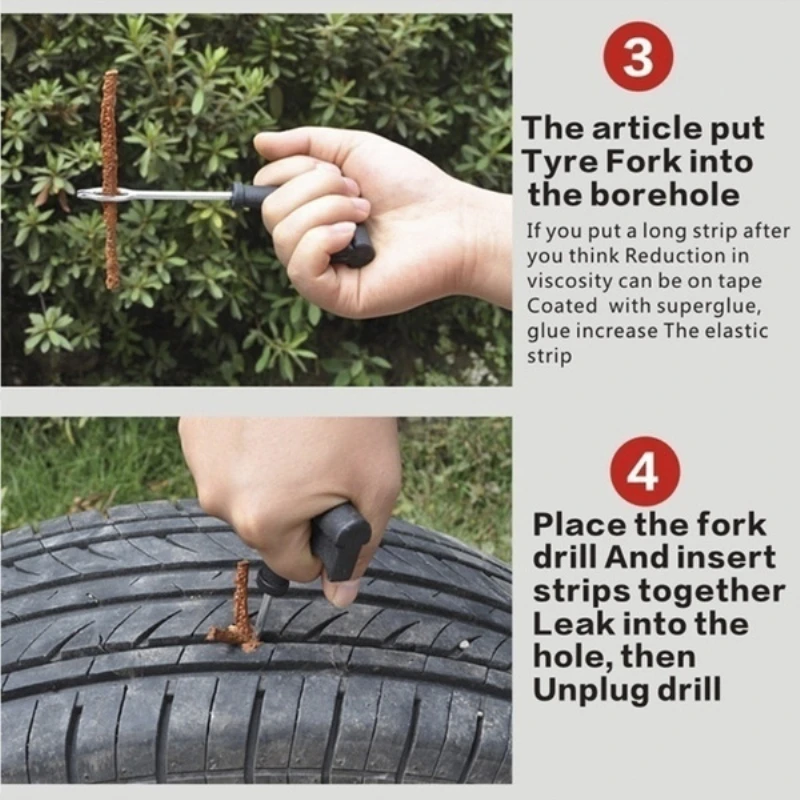 This is commonly known as a combination repair or a patch/plug repair.
This is commonly known as a combination repair or a patch/plug repair.
Patch/plug repairs are most often performed using a one-piece repair unit that combines the repair stem and cap (or patch) into one unit. However, special circumstances may require the use of a two-piece combination repair (ex. If the angle of the puncture exceeds 35 degrees). The repair is then permanently bonded to the inside of tire and through the injury channel using a cold, chemical vulcanizing process. The repair essentially becomes part of the tire, creating an air-tight seal that keeps air in and moisture and contaminants out (more on this procedure below).
Tire Plugs and String Repairs are Temporary RepairsEmergency roadside plug repairs are NOT intended to be a permanent tire repair. Plugs and string repairs are designed to get you back up and rolling long enough to get home or to the nearest service center to perform a proper tire repair.
The common misconception with plug and string repairs is that because they hold air, they are safe to use. While it is true that many plug repairs do a great job of keeping air in the tire, that’s only part of the equation. Because they’re not completely sealing the injury, plug repairs may allow air and moisture to penetrate the body of the tire. Over time, this could lead to a dangerous (or even deadly) blowout.
While it is true that many plug repairs do a great job of keeping air in the tire, that’s only part of the equation. Because they’re not completely sealing the injury, plug repairs may allow air and moisture to penetrate the body of the tire. Over time, this could lead to a dangerous (or even deadly) blowout.
A tire repair that uses only a patch is also NOT considered proper or safe. A properly installed patch will do a great job of allowing the tire to hold air. However, similarly to the plug-only repair, the patch does not fill the injury channel. Therefore, air and moisture could seep into the tire from the tread surface and eventually damage the tire.
The Proper Tire Repair Process According to Industry GuidelinesOnly a proper patch/plug repair completely seals the puncture from inside the tire and through the entire injury channel. There are a few extra steps necessary to perform a proper tire repair in accordance with industry guidelines. We’ve developed a simple acronym to help organize and remember the steps: R.E.P.A.I.R.
We’ve developed a simple acronym to help organize and remember the steps: R.E.P.A.I.R.
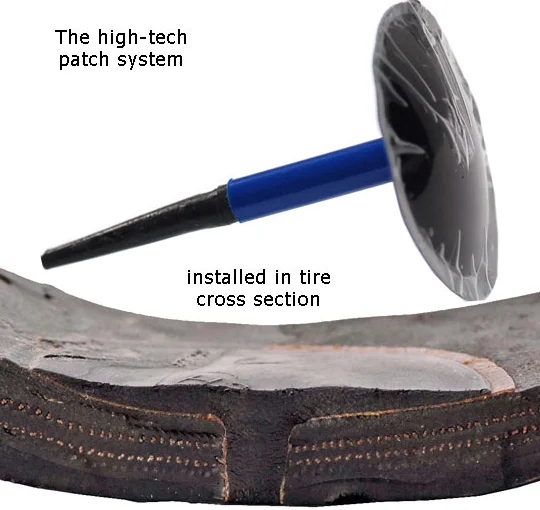 It is then allowed to air dry for 5-10 minutes.
It is then allowed to air dry for 5-10 minutes.There are a number of factors that may determine whether or not your tire is safe to repair. These factors fall into three main categories:
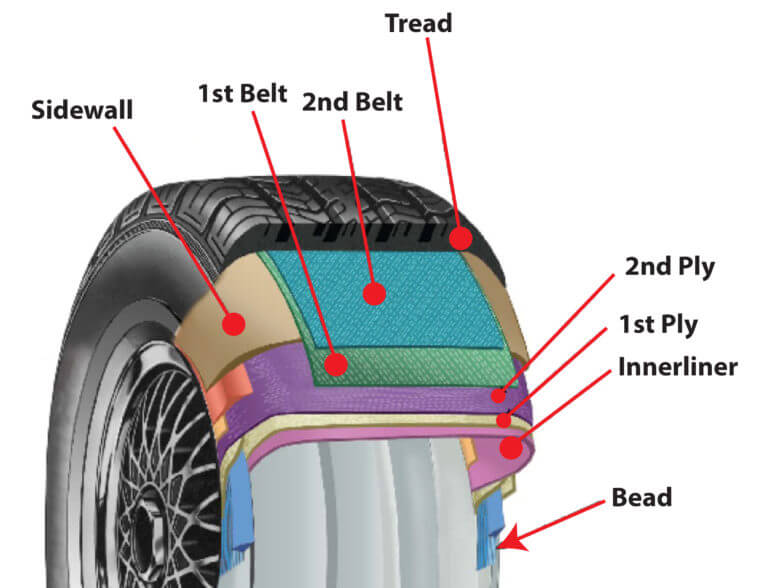
The occasional flat or leaky tire is an unavoidable part of life. But, taking shortcuts to repair it can be dangerous to you and your passengers. Take the time and do the research to do the job right and/or find a reputable tire repair shop trained in proper tire repair procedure.
esportby. com
com
An easy way to quickly restore tire tightness and continue your journey. True, for this you need to have the right wheel repair kit with you.
Maxim Stroker
“Catching” a nail, screw or piece of wire in a wheel on the track is a trifling matter and somewhere even everyday. However, it turns into a serious "trouble" if this happens, for example, at night or a couple of tens of kilometers from the nearest tire fitting point. In theory, in this case, you need to put a spare wheel and go further. Although, in the case of a family trip on vacation, the process of digging it out from under a pile of junk in the trunk can turn into an adventure that deserves a separate story. Be that as it may, often the trouble does not come alone and the spare tire can be broken literally on the next kilometer. After all, where one carnation fell on the road, there may well be another one, and another, and another ...
With a couple of crippled wheels, you'll either have to wait an unknown amount of time for a tow truck to be sent in, or fix it yourself. Therefore, in a not particularly urbanized area, it makes sense to carry a repair kit with you to eliminate punctures in tubeless wheels. In principle, it can be of any manufacturer. The main thing when choosing it in the store is to make sure that the “drill” included in the repair kit is not very toothy and sharp. After all, his task is simply to clear a puncture hole in the tire, and not to break its metal cord. The second recommendation: the flagella, which are supposed to close the puncture hole, should be plump and reinforced with thin wire or plastic threads.
Therefore, in a not particularly urbanized area, it makes sense to carry a repair kit with you to eliminate punctures in tubeless wheels. In principle, it can be of any manufacturer. The main thing when choosing it in the store is to make sure that the “drill” included in the repair kit is not very toothy and sharp. After all, his task is simply to clear a puncture hole in the tire, and not to break its metal cord. The second recommendation: the flagella, which are supposed to close the puncture hole, should be plump and reinforced with thin wire or plastic threads.
n-i.kiev.ua
And the third criterion for choosing a wheel repair kit is the obligatory presence of a tube of glue in it. Yes, yes: there are also “glueless” sets on sale, which are essentially useless.
So, we notice that the wheel is flat (or has already been blown off) and proceed to eliminate the problem. Most often, the hole in the rubber is not visible. Therefore, to begin with, we hang out the damaged wheel by raising the car on a jack, and inflate it with a pump or compressor to 3-4 atmospheres.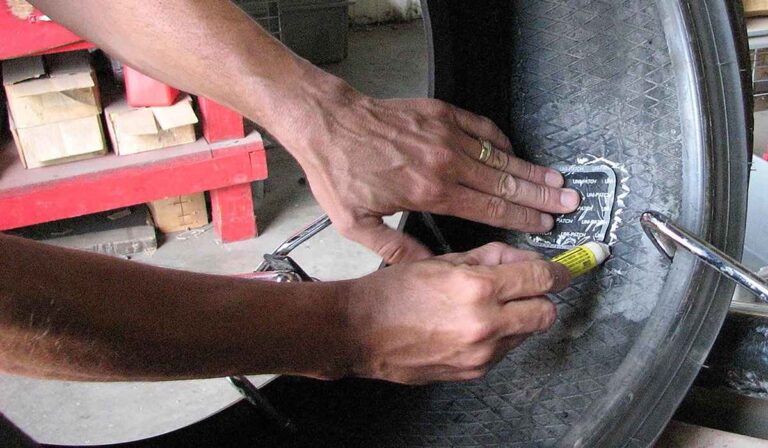 If even after that it is not possible to detect damage by the whistle of escaping air, we methodically and consistently wet the entire surface of the wheel and look for bubbles at the puncture site.
If even after that it is not possible to detect damage by the whistle of escaping air, we methodically and consistently wet the entire surface of the wheel and look for bubbles at the puncture site.
Having found a puncture, we take the “drill” from the set and pierce the damaged area with it several times. So we clean the surface of the hole before gluing. Next, we smear the “drill” with glue from the set and again immerse it in the hole. We repeat this operation and, leaving the “drill” sticking out in the hole smeared with glue, we take out the flagellum and insert it halfway into the eye of another tool - the “overgrown needle” (sometimes called the “awl”), also available in the repair kit. We coat the flagellum with glue and, quickly pulling the “drill” out of the hole, insert our “needle” there so that the ends of the flagellum remain above the surface of the wheel tread. Next, we pull out the “needle-awl” and wait a few minutes until the glue grabs. After that, we pump up the wheel and carefully cut off the protruding tails of the flagellum with a knife. Everyone, you can move on.
Everyone, you can move on.
Test drive of one of the best family minibuses
20333
Test drive of one of the best family minibuses
000 9000 9000 20000 20333 Avtovzglyad channel:wheels, summer tires, cheap cars, repairs, tires, winter tires, track
02/22/2018
Despite the objective importance of the spare tire, not all drivers always have it with them. Some do not carry a spare tire out of hope or belief that their tires are invulnerable. Others deliberately take this step, as they stocked up with a special tool in advance, which, if necessary, can eliminate a tire puncture along the way. What else can be used and how to do it right? Let's figure it out.
Contents :
Conventionally, all methods for express tire repair can be divided into two categories:
Consider ways to restore a damaged tire on the road. The first three methods are temporary. The latter, with the right approach, allows you to completely restore the tire.

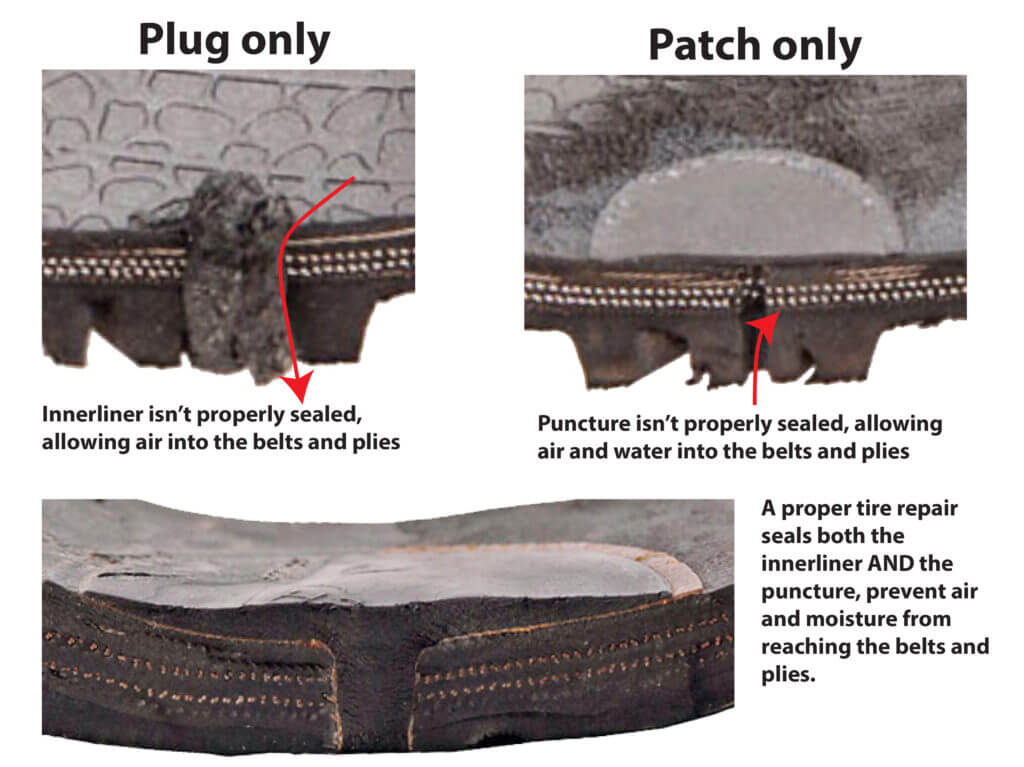 The self-tapping screw can be borrowed from the fender liner or plastic interior elements. This method will not eliminate the air leak, but will allow the car owner (perhaps with several swaps) to get to the nearest tire service.
The self-tapping screw can be borrowed from the fender liner or plastic interior elements. This method will not eliminate the air leak, but will allow the car owner (perhaps with several swaps) to get to the nearest tire service. After removing the foreign object, the hole is processed with an awl with abrasive edges: this tool must be inserted into the puncture and cleaned and developed with intensive reciprocating movements several times. Then the raw rubber tow is removed from the package and inserted into the eye of the second awl so that both ends are the same length. The hole in the tire and the raw rubber is treated with an activator. Next, the awl is inserted into the puncture in such a way that small ends of the tourniquet, about a centimeter long, remain outside. After 5 minutes, the excess remaining on the surface is cut off. This method can also successfully eliminate small side cuts.
After 5 minutes, the excess remaining on the surface is cut off. This method can also successfully eliminate small side cuts.
There is a technique that allows using wire and several bundles of raw rubber to get rid of even extensive side damage to tires. However, it is quite difficult to implement and not every driver will be able to implement it.
Consider a few well-known tools that are most widely used to repair punctures:
